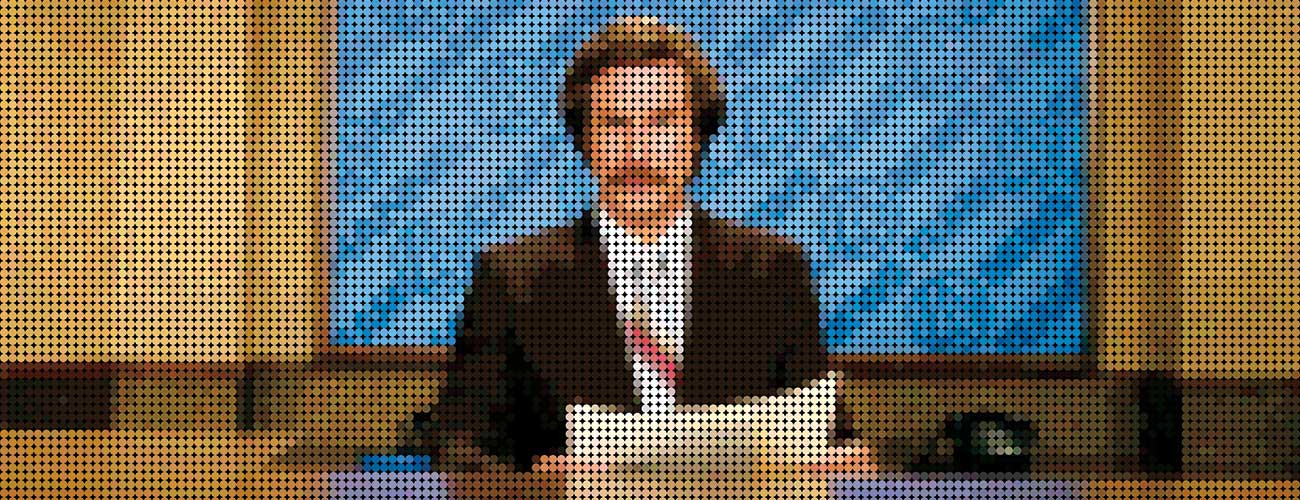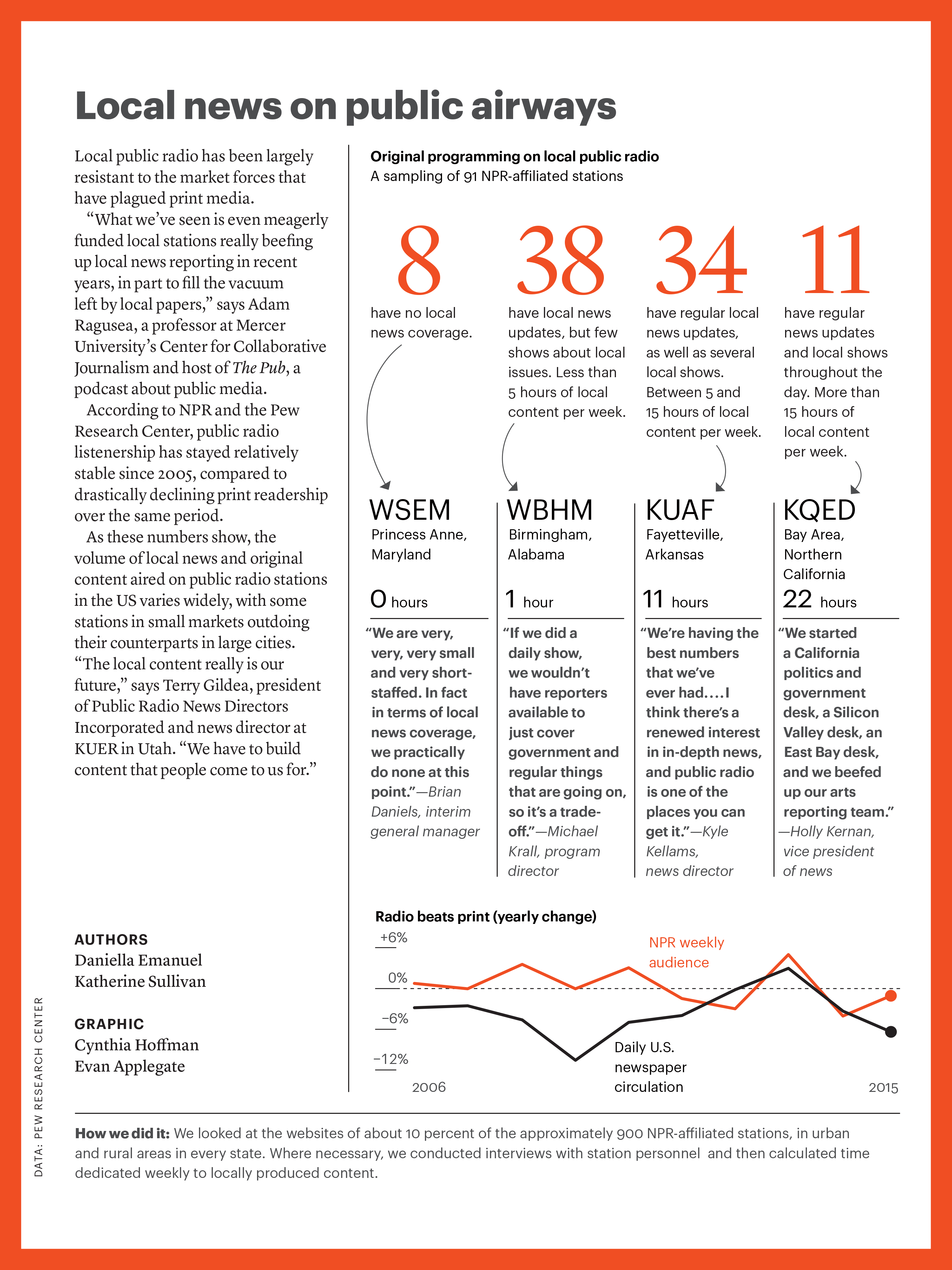Sign up for The Media Today, CJR’s daily newsletter.
Approximately 43,000 Jacksonville households are tuned into Channel 4’s 5 pm newscast on the last day of February. The first thing they see is a segment about a 26-year-old woman who filmed—and posted to Twitter—a video of herself fellating somebody in a courthouse as she awaited arraignment on a drug charge. “HAD SO MUCH FUN IN COURT TODAY. FOUND A WAY TO GET MY CHARGES DROPPED,” she wrote. This chain of events is familiar to loyal viewers, as the Florida station has been covering it for three weeks.
I’m watching the segment with Bob Longo, the news director at rival station Action News Jax. Longo is a smallish, kinetic man who established himself at television stations in upstate New York and Pittsburgh. He was hired three years ago to help lowly Action News compete with Channel 4, the longtime local ratings leader. He delights in his competitor’s bottom-feeding story-selection.
“They’re leading with the story we opted out on today,” he says, pointing at one of 13 televisions in his office. A woman in a scarlet dress appears on the screen. “This is the girl who blew that guy in the courthouse.” Channel 4’s camera, he adds, is out of focus. In my head I am congratulating Longo for abstaining from on-air prurience when he concedes that he, too, has aired segments about fellategate. “Yeah, so, we did the story originally because you know, ‘Hey, did this really go on? Where’s security? How did this happen?’ But at this point, she’s a total idiot.” Instead, Longo leads his 5 pm newscast with stories about a fire, a man killed by his girlfriend’s brother, and a deadly shooting outside a concert by the Louisiana rapper Boosie Badazz.

Photo Courtesy Paramount Pictures
Local TV news has a problem. Broadcasts are dominated by sensationalistic crime stories, weather reports, and human-interest puff pieces. The format—two plasticky news anchors reading from teleprompters—has not meaningfully changed in 40 years. The end product tends to be irrelevant journalism packaged in an increasingly irrelevant way. The problem isn’t that the product is partisan or under-resourced or “fake.” The problem is that it’s lame.
TRENDING: A hidden message in memo justifying Comey’s firing
Granted, everyone puts out a little click-bait from time to time. (I also led with the blow job story.) And network news regularly disgraces itself with breathless disaster coverage, scandal mongering, and other naked ratings grabs. So why pick on their local brethren? Because, despite the parochialism and the hokeyness, the medium remains singularly influential: According to a 2016 Pew report, more Americans get their news from local television than any other source.
Local television has for decades left much of the ingest-your-vegetables policy and enterprising reporting to print. Now fewer newspapers have the resources to do that sort of work. Meanwhile, younger consumers aren’t turning to print or television for news, suggesting a newspaper-like collapse may loom for local TV. But it isn’t in the short-term financial interest of television stations, or their owners, to address either of those problems. And so, by and large, nothing changes.
After the 5 o’clock news, I ask Longo if he hates running stories about courthouse blow jobs. Longo is both unusually candid and eager for constructive criticism. He sighs and lets a couple seconds pass. “Yeah.” Then he bursts out laughing, breaking the tension in the room. Then we sit and watch as Action News Jax runs a promo for a Dr. Phil interview with a Florida man accused of eating someone else’s face.
The modern local television broadcast was born in 1965 at Philadelphia’s CBS affiliate, KYW News. At the time, local newscasts looked Cronkite-ian: white men behind desks, gravely intoning the day’s headlines. The news director at KYW, Al Primo, decided to loosen up the format and film his reporters in the field as they gathered news. He hired women and minorities and encouraged on-air banter—this became known in the industry as “happy talk.” KYW’s broadcasts opened with anchors rushing to their places on set as the theme song from Cool Hand Luke played them in. It seems Ron Burgundy-ish now, but people loved it. Primo called the format “Eyewitness News” and it became the hottest thing in local TV.
Across town, Philadelphia’s ABC affiliate, WPVI, was plotting a counter-offensive. Rather than jazz up his set, news director Mel Kampmann went in the opposite direction. His new format was all business. Short clips, hard news, no happy talk. Viewers were bombarded with stories and too shell-shocked to switch channels. “Action News” debuted in 1970. It became the hottest thing in local TV. Since then, almost every local TV station in the country has incorporated elements of one or both formats into their news shows. “Things haven’t changed very much,” says Harry Jessell, who edits the website TV News Check. “It’s really remarkable, the sameness of the newscasts.”
TRENDING: Eleven newsletters to subscribe to if you work in media
In 2007, a group of academics and TV news veterans published a book-length study called We Interrupt This Newscast: How to Improve Local News and Win Ratings, Too. The group watched 33,000 local news stories over a five-year period. Among their findings: Over 90 percent of newscasts led with stories about crime or public safety. Over 80 percent also covered crime during their second segment. (This is probably the moment to repeat the newsroom cliché: “If it bleeds, it leads.”) Over 80 percent ended their broadcasts with a “soft-news” story, and so on. I observed that in Jacksonville: Toward the end of their broadcasts, on the same day, Channel 4 and Action News Jax covered an identical soft-news story about Hidden Figures Lego toys.
Things haven’t changed very much. It’s really remarkable, the sameness of the newscasts.”
We Interrupt This Newscast identified not just sameness, but pointless sameness, arguing convincingly that viewers don’t care all that much about homicides and fires. And yet news stations keep airing those types of stories, knowing sensational murders are an easy—and cheap— way to deliver live breaking news, which viewers say they do want. Rather than commission, say, a time-intensive investigative piece, a producer can plant herself beside a police scanner and dispatch a camera crew to a crime scene when she hears something juicy. Even if the emergency isn’t relevant to most viewers, it’s easy enough to hook them by making it look urgent or sensational.
If crime stories lead newscasts, weather reports anchor them. TV stations invest in state-of-the-art forecasting equipment and impressive meteorology staffs. The medium is well designed for weather coverage. During a March nor’easter, I flipped on NY1, New York’s all-day local news channel. It had reporters stationed in several corners of the city, wearing parkas and beanies, delivering real-time updates about the severity of the storm. For an hour, this was useful. After that, as the snowfall slowed, it became less useful. NY1 kept cycling back to the same reporters, standing in the same neighborhoods, asking passersby to comment on a storm that had mostly ended. The reporters looked marooned, or held hostage—a bit like Bill Murray (a weatherman) in Groundhog Day. After one desperate correspondent stuck a ruler in the snow—upside-down—I turned off the television.

Photo Courtesy Paramount Pictures
I asked industry veterans why weather dominates local TV. Partly, they said, it’s because there is ample research that demonstrates its popularity. But also, it makes good TV. “It’s like the NFL Today’s pre-show,” says Matt Ellis, the former news director at Boston’s CBS affiliate, WBZ. “You’ve got the storm! People can’t breathe and can’t stand upright. Then the post-game. Then the assessment. Then the replays. It’s perfect!” Fair enough. But when the storm blows over, where’s the compelling TV in five straight days of mild weather? I posed the question to Barbara Maushard, who oversees news at the Hearst Corporation’s 30 local television channels. “It’s a relationship,” she explained. “This is a human being who lives in the community, who is a scientist, who has this knowledge to help me figure out what this weather pattern is for me.”
ICYMI: Journalists, here’s what to do “when things start to get genuinely bad”
In 2007, according to Pew, 29.3 million people watched their local late night news. By 2015, that number had dipped to 22.8 million. The drop-off almost certainly reflects a generational shift in viewing habits. And there’s good reason to believe the product itself, thanks to smartphone apps, has lost much of its purpose. “Traffic, weather, and breaking news—those [are] the three staples people turn to local news for most often,” says Tom Rosenstiel, executive director of the American Press Institute and a co-author of We Interrupt This Newscast. “Those things are all pretty readily available through [other] technology today.”
This is a human being who lives in the community, who is a scientist, who has this knowledge to help me figure out what this weather pattern is for me.”
Here, according to Pew, is the percentage of people 65 and older who watch television news often: 85 percent. Of people 18-29: 27 percent. The news directors and executives I spoke with pay a lot of lip service to their expansion into new media. (The words “mobile” and “digital” are uttered frequently, mantra-like.) But many of these efforts aren’t meant to deliver news on phones; they’re meant to funnel viewers back to television. “When there’s a weather event coming into a market, you can reach [younger viewers] through their mobile and let them know, ‘You may want to tune into TV right now,’ ” says Jacques Natz, a former Indiana TV news director, who is now at consultancy SmithGeiger.
This logic is de rigueur in the industry: Local television’s response to sweeping demographic and technological change has been to double down on the core product. In 2015, according to the annual survey Bob Papper, former chair of Hofstra University’s journalism department, conducts for the Radio and Television Digital News Association (RTDNA), television stations aired more hours of local news per week than ever before. And why not? Here are some weirdly encouraging numbers: Last year, nearly 60 percent of local TV newsrooms told Papper they were profitable, up from 45 percent a decade ago. Newsroom employment also hit a 15-year high.
How is it possible that local TV news is both economically robust and less watched than ever? To an extent, it’s because news is in fact a big contributor to a station’s profitability. It’s cheaper to add an extra hour of news than pay for popular syndicated content like Ellen. According to Papper’s research, more than one third of TV newsrooms added broadcasts in 2015, and virtually none scaled back.
But the financial health of the local news industry probably has more to do with two recent legal developments than the actual strength of the business model. First, the Supreme Court’s 2010 Citizens United decision inaugurated an era in which $10 billion is spent every four years on political advertising. Much of that trickles down to local TV stations. Second, and perhaps more important, has been the growth of something called retransmission fees. In 1992, the FCC ruled that cable and satellite TV providers were essentially freeloading off the local television stations they carried, and mandated they pay an annual fee. Those fees—negotiated by cable providers and TV stations—have increased forty fold in a decade; last year, the stations reported roughly $20 billion in revenue from broadcast TV advertisements and close to $8 billion from retransmission.
The checks probably won’t come in forever. Our current president was elected without much television advertising. Once somebody figures out a way to unbundle live sports from cable TV, it will have little reason to exist in its current form. And there go the fat retransmission fees. That’s all in the future, though. “You’d be hard-pressed to find a news director who isn’t saying we need to be [innovating],” Bob Papper says. And yet, none of them really is. “The biggest hindrance to innovation,” he continues, “is the success of TV news. The fact is, it’s doing well, and if anything it may be doing better and better. That’s not an impetus to change.” All of which makes it easier than ever to whistle blithely past the graveyard, as newspapers did a generation ago.
The Jacksonville television news market, despite the odd foray into tawdry cell phone videos, is actually quite strong. Its stations regularly rack up regional Emmy awards and have a good reputation among industry insiders. It’s also a good microcosm of the business. Channel 4, a rare unaffiliated station, hews to the Eyewitness model, while Bob Longo’s outfit follows an Action News playbook. When Longo was hired three years ago as news director for the local Fox and CBS affiliates (more on that arrangement in a bit), he shook up his staff and started from scratch. He hired the youngest news anchors in town, and pushed his team to air a barrage of short, snappy segments on each half-hour broadcast. “We’re not going to have a chef, a cooking segment,” evening news anchor Tenikka Hughes tells me.
ICYMI: 11 images that show how the Trump administration is failing at photography
This is true. Action Jax sticks faithfully to hard news. Several of the segments I saw on my visit were aggressively reported. In one, a reporter wandered onto the lot of a local car dealership accused of selling lemons. It could have been a banal story—aren’t all used car dealers crooks?—but the reporter poked around until he met the owner face-to-face and confronted him with evidence that he had been fined by the state attorney general. “So?” replied the owner, wearing absurd sunglasses. I watched as another reporter uncovered wasteful spending by a city parks department. A story about a local doctor caught in a sordid love triangle also revealed that he was a notorious prescription pill pusher. There were misses, too. Longo devoted a rather lengthy segment to the Trump administration’s decision to move an initiative on historically black colleges out of the Department of Education and into the White House. The move was interpreted elsewhere as a PR stunt, but Hughes, the anchor, unquestioningly touted it as a move that “could give a much-needed boost to schools in Florida.”
Longo, perennial underdog, judges the impact of his segments largely on whether or not they bite a chunk out of Channel 4’s ratings. For Jacksonville TV-watchers, the stakes are very different. The city’s CBS and FOX affiliate stations are both effectively owned by Cox. They operate out of a single newsroom, meaning the same reporters and broadcasts appear on both channels, sometimes simultaneously. It’s a similar deal with Jacksonville’s ABC and NBC affiliates, which are owned by Gannett’s broadcast division, recently spun off as TEGNA. Including Channel 4, Jacksonville has five television channels that air just three news broadcasts.

Photo Courtesy Paramount Pictures
In 2006 and 2013, the industry saw two massive waves of corporate consolidation. Today, the four largest TV chains—Sinclair, Nexstar, Gray, Tribune—own one-third of all local stations in the country. Donald Trump’s new FCC chairman, Ajit Pai, has indicated he will lift existing ownership caps, which will likely create new mergers. This year, Sinclair is expected to buy Tribune’s assets and assume control of its 39 local TV stations. The reasoning behind such deals is simple: More stations lead to more efficiencies, which lead to more profits. For example, massive chains can create DC bureaus that broadcast identical national politics spots across the country. According to Bob Papper, a quarter of local broadcasts are airing news produced by other stations. “From the viewer’s perspective,” says one TV consultant who asked to remain anonymous, “there’s no upside to consolidation.” For the stations, however, it’s been a windfall.
The day after my watch party with Bob Longo, I meet his rival, Bob Ellis, for lunch at a Mediterranean restaurant in an SUV-saturated pocket of Jacksonville. Ellis is Channel 4’s general manager. He’s wearing a suit and pink tie, and a Michigan State class ring on his right hand. Channel 4 has staked its brand on the gravitas and longevity of its on-air talent. Evening Anchor Tom Wills has been sitting in the same chair for 35 years; his partner Mary Baer has been there for 22 of them. Their tagline could be Trustworthy and Avuncular.
ICYMI: Journalists, here’s what to do “when things start to get genuinely bad”
I ask Ellis how he plans to attract a generation of non-television-watching younger folk. He rejects the premise. “I think there’s a misnomer here. We’ve studied this. We’ve done a lot of research on the subject,” he says, cutting into his hamburger with a knife and fork. “There’s this belief that’s being perpetuated that younger people don’t care about news. Well, you know what, they didn’t care about it 50 years ago, either. Local news or news in general becomes more important in your life, for the masses, as you get older, when you have kids.” In other words: By the time they become valuable to advertisers, the supposedly idiot-box-averse millennial generation will be watching local TV news as their parents and grandparents did before them.
After lunch, I drive back to Channel 4 and sit down in a conference room with Tom Wills and his news director, Kathryn Bonfield. I ask if they think local TV is prepared to fill the vacuum if Jacksonville one day loses its newspaper. My point is that it might behoove them go deeper on certain stories and link their bread-and-butter crime stories to, say, America’s gun violence epidemic. Wills says they’re already on it. “When we report on car burglaries,” he says, “we find out if the gun was stolen from the car, and invariably, somebody left a gun in an unlocked car. So we don’t miss an opportunity to say to people: ‘Lock your doors! Don’t leave your gun in your car!’ ”
The biggest hindrance to innovation is the success of TV news. The fact is, it’s doing well, and if anything it may be doing better and better. That’s not an impetus to change.”
There are ways stations like Channel 4 could diversify their audiences and better serve their cities. As newspapers shrink, talented young reporters are looking for jobs. TV stations could build out digital-only staffs on the cheap. It’s what CBS-affiliate WPRI did in Providence, Rhode Island, where Ted Nesi and Dan McGowan were given free reign to cover state and local politics as though they were newspaper reporters. They appear on TV but mainly report for the station’s website, and have become the go-to political news source in Rhode Island.
That’s rare on the local level, but MSNBC, CNN, and the Big Three networks have all built robust stand-alone digital teams. Yet when I broach the idea with local TV news pooh-bahs, I hear crickets. “My only feeling is that broadcast stations need to continue to program to where the viewership is,” says Mike Cavender, RTDNA’s executive director. Barbara Maushard, of Hearst, suggests my idea is hmm, interesting. “We do have a handful of digital employees that kind of manage the digital sites. But everybody on the teams [is] contributing on all platforms.”
Local news executives have good reason to avoid risk: They’re actually expected to make real money. Industry consolidation means more stations are owned by publicly traded corporations with unforgiving shareholders. “TV stations are not going to turn around and lose money to hire reporters and do the type of reporting you might see from NBC News, The Wall Street Journal, or 60 Minutes,” says Steve Schwaid, a former news director in Philadelphia, now with consultancy Crawford Johnson & Northcott. “The problem for TV stations,” Schwaid says, “is they are adverse to starting something up unless they can see money by the second or third quarter.”
Before I leave Jacksonville, I accompany Channel 4 reporter Jim Piggott on his daily morning visit to City Hall. I find it encouraging that Bob Ellis still employs a political beat reporter. Piggott checks in with the city’s public affairs officer, then rifles through the mayor’s correspondence and other ephemera, hunting for promising stories. One item that catches his eye concerns the CEO of the Jacksonville Port Authority, who has been getting heat from a member of his board for missing meetings. Piggott likes the story, but the paper is already on it, and he doesn’t think he can sell it to his team as a TV piece. “It’s not sexy enough,” he explains. A week later, it gets sexier when the CEO resigns. And the Florida Times-Union has the story all to itself.
Local news on public airways
Local public radio has been largely resistant to the market forces that have plagued print media.
“What we’ve seen is even meagerly funded local stations really beefing up local news reporting in recent years, in part to fill the vacuum left by local papers,” says Adam Ragusea, a professor at Mercer University’s Center for Collaborative Journalism and host of The Pub, a podcast about public media.
According to NPR and the Pew Research Center, public radio listenership has stayed relatively stable since 2005, compared to drastically declining print readership over the same period.
As these numbers show, the volume of local news and original content aired on public radio stations in the US varies widely, with some stations in small markets outdoing their counterparts in large cities. “The local content really is our future,” says Terry Gildea, president of Public Radio News Directors Incorporated and news director at KUER in Utah. “We have to build content that people come to us for.”
—Daniella Emanuel and Katherine Sullivan
Click on the graphic below to view a breakdown of original programming on 91 NPR-affiliated stations.
ICYMI: A graphic that shows how much local news is suffering
Has America ever needed a media defender more than now? Help us by joining CJR today.




